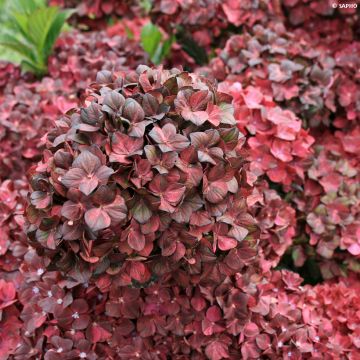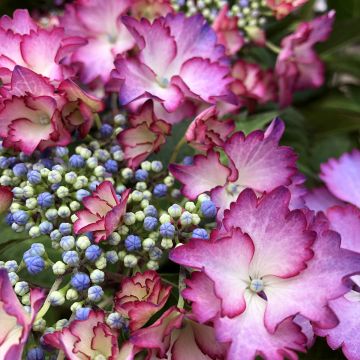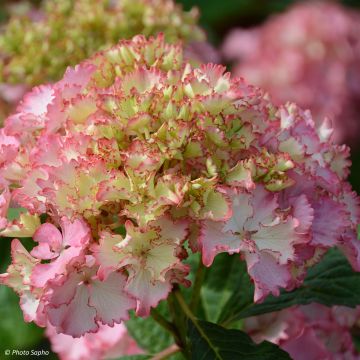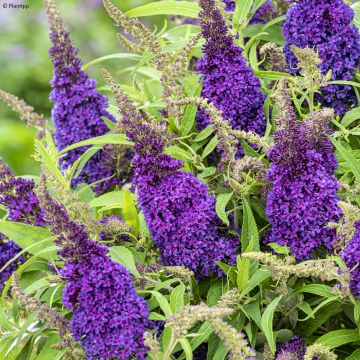

Hortensia - Hydrangea macrophylla Nachtigall


Hortensia - Hydrangea macrophylla Nachtigall
Hydrangea macrophylla Nachtigall
Hydrangea macrophylla Nachtigall
Bigleaf Hydrangea, French Hydrangea
The young plant was beautiful, much taller than the other hydrangea. It is very green now. We'll see about the flowers.
Francine L., 18/04/2017
Special offer!
Receive a €20 voucher for any order over €90 (excluding delivery costs, credit notes, and plastic-free options)!
1- Add your favorite plants to your cart.
2- Once you have reached €90, confirm your order (you can even choose the delivery date!).
3- As soon as your order is shipped, you will receive an email containing your voucher code, valid for 3 months (90 days).
Your voucher is unique and can only be used once, for any order with a minimum value of €20, excluding delivery costs.
Can be combined with other current offers, non-divisible and non-refundable.
Why not try an alternative variety in stock?
View all →This plant carries a 24 months recovery warranty
More information
We guarantee the quality of our plants for a full growing cycle, and will replace at our expense any plant that fails to recover under normal climatic and planting conditions.


Would this plant suit my garden?
Set up your Plantfit profile →
Description
The Hydrangea macrophylla Natchigall, with large flat flower heads, is undoubtedly one of the bluest. Its flowers can reach a purplish-violet shade in acidic soil, remaining dark pink and almost red in neutral ground. This medium-sized variety forms sturdy stems on a bush with a low habit, taking on beautiful colours in autumn. Its generous flowering lasts all summer. It is perfect for adding colour to the garden and making fresh or dry bouquets. To be grown in shaded beds, in fresh and non-limestone soil.
Hydrangea macrophylla Natchigall is one of the many hybrids obtained by cross-breeding the species H. macrophylla and H. aspera, among others. All these hardy plants belong to the Hydrangeaceae family, originating from China and Japan. This bush has a compact habit, as wide as it is tall, 1.50 m (4 ft 11 in) in all directions, at the age of 10 years. From July to October, these small fertile and sterile flowers, with striking dimorphism, form flat flower heads of 15 to 20 cm (5.9 to 7.9 in) in diameter. They are formed of a central bouquet of tiny fertile florets, first green, then white, then bluing up to ultramarine, surrounded by a crown of large sterile florets where intense blue and violet mix. In aluminium-poor soil, it turns shades of pink to red, creating a beautiful effect. The flowers fade into a texture resembling paper, in faded tones that remarkably match the autumn foliage. The flowering is accompanied by medium green, deciduous leaves. The leaves are opposite; they reach a minimum of ten centimetres in length. They are single, ovate to elliptical, ending in a tapered point, saw-toothed. Hydrangeas can live for at least 50 years.
The Natchigall Hydrangea has good hardiness and is adorned with a unique and intense shade, remarkable for brightening up the north side of the house. It will be happy in an east or west exposure that is not burning, in beds and hedges. This variety is particularly suited to growing in the open ground, whether to create a backdrop in front of perennial beds, near the terrace or at the entrance of a property. All hydrangeas can be grown in large pots. Even though they are not fond of limestone, they are not strictly ericaceous plants. The colour of the flowers often depends on the soil, leading to beautiful colour battles. Pair them with fuchsia magellanica, annual impatiens, or plant spring-flowering bulbs in front of their round shape. Enjoy their sumptuous and long-lasting flowering in the garden or the house.
Note: The colour of the flowers of the hydrangea macrophylla varies according to the PH of the soil. Traditionally blue varieties turn pink in neutral or alkaline soil. To maintain a beautiful blue colour, mix ericaceous compost with your garden soil and apply aluminium sulphate (slate contains it) or alum stone every year in spring.
Report an error about the product description
Hydrangea macrophylla Nachtigall in pictures




Plant habit
Flowering
Foliage
Botanical data
Hydrangea
macrophylla
Nachtigall
Hydrangeaceae
Bigleaf Hydrangea, French Hydrangea
Cultivar or hybrid
Other Hydrangea Macrophylla
View all →Planting and care
When planting the hydrangea macrophylla 'Nachtigall' choose a slightly shaded spot in spring or early autumn, such as against an east-facing or northern wall. Keep it away from cold winds and the sun. It prefers deep, fresh, well-drained, and relatively fertile soil, but ericaceous soil is unnecessary. You can enrich the soil with a good base fertiliser before planting. If the soil is dry at the foot of the wall, plant the root ball at least 30-40 cm (11.8-15.7 in) away from the base and add well-rotted compost to improve soil freshness. This plant is resilient and can be planted in cold areas. When pruning, remove the faded flowers on the first or second bud. To encourage the formation of young shoots, cut back a quarter or a third of the oldest stems to the base when the plant matures. Prune every year in March or April.
Planting period
Intended location
Care
-
, onOrder confirmed
Reply from on Promesse de fleurs
Similar products
Haven't found what you were looking for?
Hardiness is the lowest winter temperature a plant can endure without suffering serious damage or even dying. However, hardiness is affected by location (a sheltered area, such as a patio), protection (winter cover) and soil type (hardiness is improved by well-drained soil).

Photo Sharing Terms & Conditions
In order to encourage gardeners to interact and share their experiences, Promesse de fleurs offers various media enabling content to be uploaded onto its Site - in particular via the ‘Photo sharing’ module.
The User agrees to refrain from:
- Posting any content that is illegal, prejudicial, insulting, racist, inciteful to hatred, revisionist, contrary to public decency, that infringes on privacy or on the privacy rights of third parties, in particular the publicity rights of persons and goods, intellectual property rights, or the right to privacy.
- Submitting content on behalf of a third party;
- Impersonate the identity of a third party and/or publish any personal information about a third party;
In general, the User undertakes to refrain from any unethical behaviour.
All Content (in particular text, comments, files, images, photos, videos, creative works, etc.), which may be subject to property or intellectual property rights, image or other private rights, shall remain the property of the User, subject to the limited rights granted by the terms of the licence granted by Promesse de fleurs as stated below. Users are at liberty to publish or not to publish such Content on the Site, notably via the ‘Photo Sharing’ facility, and accept that this Content shall be made public and freely accessible, notably on the Internet.
Users further acknowledge, undertake to have ,and guarantee that they hold all necessary rights and permissions to publish such material on the Site, in particular with regard to the legislation in force pertaining to any privacy, property, intellectual property, image, or contractual rights, or rights of any other nature. By publishing such Content on the Site, Users acknowledge accepting full liability as publishers of the Content within the meaning of the law, and grant Promesse de fleurs, free of charge, an inclusive, worldwide licence for the said Content for the entire duration of its publication, including all reproduction, representation, up/downloading, displaying, performing, transmission, and storage rights.
Users also grant permission for their name to be linked to the Content and accept that this link may not always be made available.
By engaging in posting material, Users consent to their Content becoming automatically accessible on the Internet, in particular on other sites and/or blogs and/or web pages of the Promesse de fleurs site, including in particular social pages and the Promesse de fleurs catalogue.
Users may secure the removal of entrusted content free of charge by issuing a simple request via our contact form.
The flowering period indicated on our website applies to countries and regions located in USDA zone 8 (France, the United Kingdom, Ireland, the Netherlands, etc.)
It will vary according to where you live:
- In zones 9 to 10 (Italy, Spain, Greece, etc.), flowering will occur about 2 to 4 weeks earlier.
- In zones 6 to 7 (Germany, Poland, Slovenia, and lower mountainous regions), flowering will be delayed by 2 to 3 weeks.
- In zone 5 (Central Europe, Scandinavia), blooming will be delayed by 3 to 5 weeks.
In temperate climates, pruning of spring-flowering shrubs (forsythia, spireas, etc.) should be done just after flowering.
Pruning of summer-flowering shrubs (Indian Lilac, Perovskia, etc.) can be done in winter or spring.
In cold regions as well as with frost-sensitive plants, avoid pruning too early when severe frosts may still occur.
The planting period indicated on our website applies to countries and regions located in USDA zone 8 (France, United Kingdom, Ireland, Netherlands).
It will vary according to where you live:
- In Mediterranean zones (Marseille, Madrid, Milan, etc.), autumn and winter are the best planting periods.
- In continental zones (Strasbourg, Munich, Vienna, etc.), delay planting by 2 to 3 weeks in spring and bring it forward by 2 to 4 weeks in autumn.
- In mountainous regions (the Alps, Pyrenees, Carpathians, etc.), it is best to plant in late spring (May-June) or late summer (August-September).
The harvesting period indicated on our website applies to countries and regions in USDA zone 8 (France, England, Ireland, the Netherlands).
In colder areas (Scandinavia, Poland, Austria...) fruit and vegetable harvests are likely to be delayed by 3-4 weeks.
In warmer areas (Italy, Spain, Greece, etc.), harvesting will probably take place earlier, depending on weather conditions.
The sowing periods indicated on our website apply to countries and regions within USDA Zone 8 (France, UK, Ireland, Netherlands).
In colder areas (Scandinavia, Poland, Austria...), delay any outdoor sowing by 3-4 weeks, or sow under glass.
In warmer climes (Italy, Spain, Greece, etc.), bring outdoor sowing forward by a few weeks.

























































